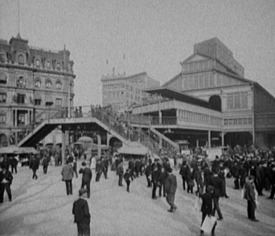Structure Elevated Next south Sands Street Borough Manhattan Platforms in use 3 | Next north (Terminus) Opened 1883 Locale Park Row | |
 | ||
Services BMT Fulton Street Line
BMT Myrtle Avenue Line
BMT Lexington Avenue Line
BMT Fifth Avenue Line Tracks 6 (4 main terminal, 2 west end) Closed 1950; 67 years ago (1950) Similar Sands Street, Dyckman‑Hillside Substation, Corbin Building, Myrtle Avenue, City Hall | ||
Park Row was a major elevated railway terminal constructed over the New York end of the Brooklyn Bridge, across from New York City Hall in Manhattan that served as the terminal for BMT services operating over the Brooklyn Bridge Elevated Line from the BMT Fulton Street Line, BMT Myrtle Avenue Line and their feeders. Until the opening of the nearby Williamsburg Bridge to elevated train traffic in 1913, it was the only Manhattan station available for elevated trains from Brooklyn, and the only elevated station in Manhattan to be owned by a company other than the IRT or its predecessors.
Contents
Early history (1883-1913)
For the first decade-and-a-half of its existence, it was used exclusively by trains of the New York and Brooklyn Bridge Railway, a cable-hauled line that spanned the length of the bridge between Park Row and another terminal at the Brooklyn end of the bridge.
On June 18, 1898, elevated trains of predecessor companies of the BMT began using the station during off-peak hours, while the cable-hauled shuttle continued to run at rush hours. On January 27, 1908 the shuttle was eliminated and elevated trains began running to Park Row at all times.
At its height, Park Row terminal had four platforms on four tracks in the main part of the terminal, and another three platforms on two tracks beyond (west of) the main train shed. This resulted in very complex scheduling and track shifting, so that most trains discharged their passengers at dedicated exit platforms and then were transferred to tracks on other platforms for loading of outgoing passengers. From the turn of the 20th century until 1913, the following lines were hosted at least part-time at Park Row:
From Fulton Street Line (Kings County Elevated Railway)
From Myrtle Avenue Line (Brooklyn Union Elevated Railway)
Gradual decline (1913-1940)
As new bridges and new subways took the pressure off the Brooklyn Bridge services, ridership at Park Row gradually declined.
Services withdrawn from terminal
Final operations (1940-1950)
Brooklyn Bridge streetcars were shifted to the elevated tracks and used them until 1950, when all transit was removed from the bridge. The streetcars did not use the Park Row terminal, but continued to use the trolley loops beneath the train shed, which was torn down.
